Input interpretation

O_2 oxygen + NO_2 nitrogen dioxide + Ca(OH)_2 calcium hydroxide ⟶ H_2O water + Ca(NO_3)_2 calcium nitrate
Balanced equation

Balance the chemical equation algebraically: O_2 + NO_2 + Ca(OH)_2 ⟶ H_2O + Ca(NO_3)_2 Add stoichiometric coefficients, c_i, to the reactants and products: c_1 O_2 + c_2 NO_2 + c_3 Ca(OH)_2 ⟶ c_4 H_2O + c_5 Ca(NO_3)_2 Set the number of atoms in the reactants equal to the number of atoms in the products for O, N, Ca and H: O: | 2 c_1 + 2 c_2 + 2 c_3 = c_4 + 6 c_5 N: | c_2 = 2 c_5 Ca: | c_3 = c_5 H: | 2 c_3 = 2 c_4 Since the coefficients are relative quantities and underdetermined, choose a coefficient to set arbitrarily. To keep the coefficients small, the arbitrary value is ordinarily one. For instance, set c_1 = 1 and solve the system of equations for the remaining coefficients: c_1 = 1 c_2 = 4 c_3 = 2 c_4 = 2 c_5 = 2 Substitute the coefficients into the chemical reaction to obtain the balanced equation: Answer: | | O_2 + 4 NO_2 + 2 Ca(OH)_2 ⟶ 2 H_2O + 2 Ca(NO_3)_2
Structures
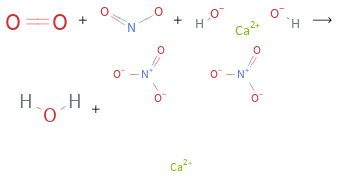
+ + ⟶ +
Names

oxygen + nitrogen dioxide + calcium hydroxide ⟶ water + calcium nitrate
Reaction thermodynamics
Enthalpy
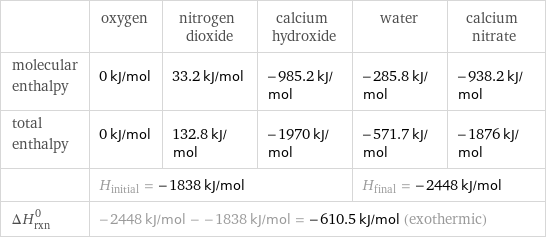
| oxygen | nitrogen dioxide | calcium hydroxide | water | calcium nitrate molecular enthalpy | 0 kJ/mol | 33.2 kJ/mol | -985.2 kJ/mol | -285.8 kJ/mol | -938.2 kJ/mol total enthalpy | 0 kJ/mol | 132.8 kJ/mol | -1970 kJ/mol | -571.7 kJ/mol | -1876 kJ/mol | H_initial = -1838 kJ/mol | | | H_final = -2448 kJ/mol | ΔH_rxn^0 | -2448 kJ/mol - -1838 kJ/mol = -610.5 kJ/mol (exothermic) | | | |
Gibbs free energy
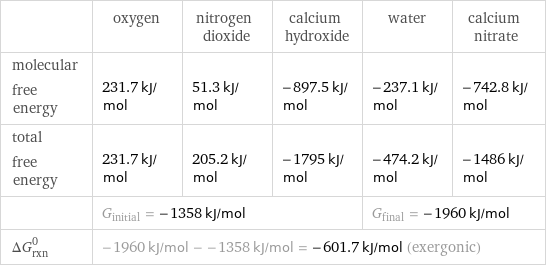
| oxygen | nitrogen dioxide | calcium hydroxide | water | calcium nitrate molecular free energy | 231.7 kJ/mol | 51.3 kJ/mol | -897.5 kJ/mol | -237.1 kJ/mol | -742.8 kJ/mol total free energy | 231.7 kJ/mol | 205.2 kJ/mol | -1795 kJ/mol | -474.2 kJ/mol | -1486 kJ/mol | G_initial = -1358 kJ/mol | | | G_final = -1960 kJ/mol | ΔG_rxn^0 | -1960 kJ/mol - -1358 kJ/mol = -601.7 kJ/mol (exergonic) | | | |
Equilibrium constant
![Construct the equilibrium constant, K, expression for: O_2 + NO_2 + Ca(OH)_2 ⟶ H_2O + Ca(NO_3)_2 Plan: • Balance the chemical equation. • Determine the stoichiometric numbers. • Assemble the activity expression for each chemical species. • Use the activity expressions to build the equilibrium constant expression. Write the balanced chemical equation: O_2 + 4 NO_2 + 2 Ca(OH)_2 ⟶ 2 H_2O + 2 Ca(NO_3)_2 Assign stoichiometric numbers, ν_i, using the stoichiometric coefficients, c_i, from the balanced chemical equation in the following manner: ν_i = -c_i for reactants and ν_i = c_i for products: chemical species | c_i | ν_i O_2 | 1 | -1 NO_2 | 4 | -4 Ca(OH)_2 | 2 | -2 H_2O | 2 | 2 Ca(NO_3)_2 | 2 | 2 Assemble the activity expressions accounting for the state of matter and ν_i: chemical species | c_i | ν_i | activity expression O_2 | 1 | -1 | ([O2])^(-1) NO_2 | 4 | -4 | ([NO2])^(-4) Ca(OH)_2 | 2 | -2 | ([Ca(OH)2])^(-2) H_2O | 2 | 2 | ([H2O])^2 Ca(NO_3)_2 | 2 | 2 | ([Ca(NO3)2])^2 The equilibrium constant symbol in the concentration basis is: K_c Mulitply the activity expressions to arrive at the K_c expression: Answer: | | K_c = ([O2])^(-1) ([NO2])^(-4) ([Ca(OH)2])^(-2) ([H2O])^2 ([Ca(NO3)2])^2 = (([H2O])^2 ([Ca(NO3)2])^2)/([O2] ([NO2])^4 ([Ca(OH)2])^2)](../image_source/c2e3b3b47819df68d02f881b848316fb.png)
Construct the equilibrium constant, K, expression for: O_2 + NO_2 + Ca(OH)_2 ⟶ H_2O + Ca(NO_3)_2 Plan: • Balance the chemical equation. • Determine the stoichiometric numbers. • Assemble the activity expression for each chemical species. • Use the activity expressions to build the equilibrium constant expression. Write the balanced chemical equation: O_2 + 4 NO_2 + 2 Ca(OH)_2 ⟶ 2 H_2O + 2 Ca(NO_3)_2 Assign stoichiometric numbers, ν_i, using the stoichiometric coefficients, c_i, from the balanced chemical equation in the following manner: ν_i = -c_i for reactants and ν_i = c_i for products: chemical species | c_i | ν_i O_2 | 1 | -1 NO_2 | 4 | -4 Ca(OH)_2 | 2 | -2 H_2O | 2 | 2 Ca(NO_3)_2 | 2 | 2 Assemble the activity expressions accounting for the state of matter and ν_i: chemical species | c_i | ν_i | activity expression O_2 | 1 | -1 | ([O2])^(-1) NO_2 | 4 | -4 | ([NO2])^(-4) Ca(OH)_2 | 2 | -2 | ([Ca(OH)2])^(-2) H_2O | 2 | 2 | ([H2O])^2 Ca(NO_3)_2 | 2 | 2 | ([Ca(NO3)2])^2 The equilibrium constant symbol in the concentration basis is: K_c Mulitply the activity expressions to arrive at the K_c expression: Answer: | | K_c = ([O2])^(-1) ([NO2])^(-4) ([Ca(OH)2])^(-2) ([H2O])^2 ([Ca(NO3)2])^2 = (([H2O])^2 ([Ca(NO3)2])^2)/([O2] ([NO2])^4 ([Ca(OH)2])^2)
Rate of reaction
![Construct the rate of reaction expression for: O_2 + NO_2 + Ca(OH)_2 ⟶ H_2O + Ca(NO_3)_2 Plan: • Balance the chemical equation. • Determine the stoichiometric numbers. • Assemble the rate term for each chemical species. • Write the rate of reaction expression. Write the balanced chemical equation: O_2 + 4 NO_2 + 2 Ca(OH)_2 ⟶ 2 H_2O + 2 Ca(NO_3)_2 Assign stoichiometric numbers, ν_i, using the stoichiometric coefficients, c_i, from the balanced chemical equation in the following manner: ν_i = -c_i for reactants and ν_i = c_i for products: chemical species | c_i | ν_i O_2 | 1 | -1 NO_2 | 4 | -4 Ca(OH)_2 | 2 | -2 H_2O | 2 | 2 Ca(NO_3)_2 | 2 | 2 The rate term for each chemical species, B_i, is 1/ν_i(Δ[B_i])/(Δt) where [B_i] is the amount concentration and t is time: chemical species | c_i | ν_i | rate term O_2 | 1 | -1 | -(Δ[O2])/(Δt) NO_2 | 4 | -4 | -1/4 (Δ[NO2])/(Δt) Ca(OH)_2 | 2 | -2 | -1/2 (Δ[Ca(OH)2])/(Δt) H_2O | 2 | 2 | 1/2 (Δ[H2O])/(Δt) Ca(NO_3)_2 | 2 | 2 | 1/2 (Δ[Ca(NO3)2])/(Δt) (for infinitesimal rate of change, replace Δ with d) Set the rate terms equal to each other to arrive at the rate expression: Answer: | | rate = -(Δ[O2])/(Δt) = -1/4 (Δ[NO2])/(Δt) = -1/2 (Δ[Ca(OH)2])/(Δt) = 1/2 (Δ[H2O])/(Δt) = 1/2 (Δ[Ca(NO3)2])/(Δt) (assuming constant volume and no accumulation of intermediates or side products)](../image_source/9fdd667718927190f52931b141d6724c.png)
Construct the rate of reaction expression for: O_2 + NO_2 + Ca(OH)_2 ⟶ H_2O + Ca(NO_3)_2 Plan: • Balance the chemical equation. • Determine the stoichiometric numbers. • Assemble the rate term for each chemical species. • Write the rate of reaction expression. Write the balanced chemical equation: O_2 + 4 NO_2 + 2 Ca(OH)_2 ⟶ 2 H_2O + 2 Ca(NO_3)_2 Assign stoichiometric numbers, ν_i, using the stoichiometric coefficients, c_i, from the balanced chemical equation in the following manner: ν_i = -c_i for reactants and ν_i = c_i for products: chemical species | c_i | ν_i O_2 | 1 | -1 NO_2 | 4 | -4 Ca(OH)_2 | 2 | -2 H_2O | 2 | 2 Ca(NO_3)_2 | 2 | 2 The rate term for each chemical species, B_i, is 1/ν_i(Δ[B_i])/(Δt) where [B_i] is the amount concentration and t is time: chemical species | c_i | ν_i | rate term O_2 | 1 | -1 | -(Δ[O2])/(Δt) NO_2 | 4 | -4 | -1/4 (Δ[NO2])/(Δt) Ca(OH)_2 | 2 | -2 | -1/2 (Δ[Ca(OH)2])/(Δt) H_2O | 2 | 2 | 1/2 (Δ[H2O])/(Δt) Ca(NO_3)_2 | 2 | 2 | 1/2 (Δ[Ca(NO3)2])/(Δt) (for infinitesimal rate of change, replace Δ with d) Set the rate terms equal to each other to arrive at the rate expression: Answer: | | rate = -(Δ[O2])/(Δt) = -1/4 (Δ[NO2])/(Δt) = -1/2 (Δ[Ca(OH)2])/(Δt) = 1/2 (Δ[H2O])/(Δt) = 1/2 (Δ[Ca(NO3)2])/(Δt) (assuming constant volume and no accumulation of intermediates or side products)
Chemical names and formulas
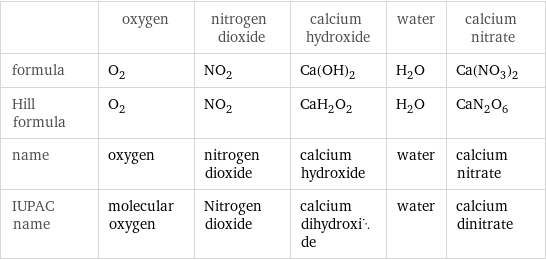
| oxygen | nitrogen dioxide | calcium hydroxide | water | calcium nitrate formula | O_2 | NO_2 | Ca(OH)_2 | H_2O | Ca(NO_3)_2 Hill formula | O_2 | NO_2 | CaH_2O_2 | H_2O | CaN_2O_6 name | oxygen | nitrogen dioxide | calcium hydroxide | water | calcium nitrate IUPAC name | molecular oxygen | Nitrogen dioxide | calcium dihydroxide | water | calcium dinitrate
Substance properties
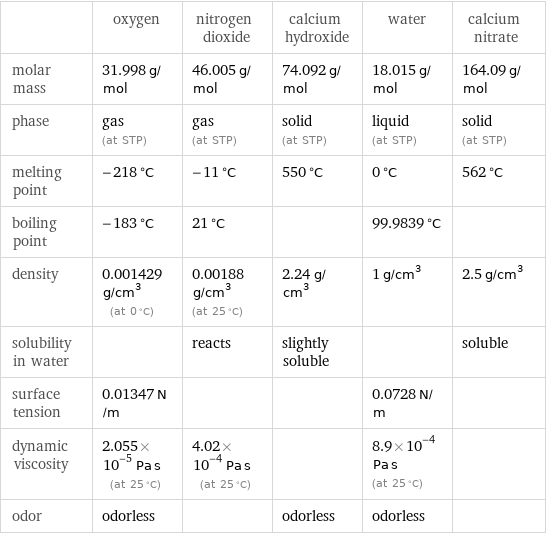
| oxygen | nitrogen dioxide | calcium hydroxide | water | calcium nitrate molar mass | 31.998 g/mol | 46.005 g/mol | 74.092 g/mol | 18.015 g/mol | 164.09 g/mol phase | gas (at STP) | gas (at STP) | solid (at STP) | liquid (at STP) | solid (at STP) melting point | -218 °C | -11 °C | 550 °C | 0 °C | 562 °C boiling point | -183 °C | 21 °C | | 99.9839 °C | density | 0.001429 g/cm^3 (at 0 °C) | 0.00188 g/cm^3 (at 25 °C) | 2.24 g/cm^3 | 1 g/cm^3 | 2.5 g/cm^3 solubility in water | | reacts | slightly soluble | | soluble surface tension | 0.01347 N/m | | | 0.0728 N/m | dynamic viscosity | 2.055×10^-5 Pa s (at 25 °C) | 4.02×10^-4 Pa s (at 25 °C) | | 8.9×10^-4 Pa s (at 25 °C) | odor | odorless | | odorless | odorless |
Units
